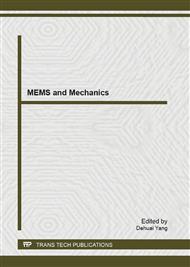p.405
p.410
p.415
p.419
p.424
p.429
p.436
p.442
p.448
Modeling and Analysis of Size Effects on Pure Copper Mechanical Behaviors in Micro Scale Plastic Deformation Processes
Abstract:
To verify the applicability of a comprehensive constitutive model, which was proposed to analyze size effects in micro plastic deformation, mechanical behaviors of pure copper was adopted as the investigated subject. Unknown parameters were fitted through least square method, and calculated results were compared with experiment data of pure copper as well as those obtained by surface model. Predicted results by the comprehensive model show good agreement with experiment data. Three distinct mechanical domains appear indicating that for pure copper two critical thickness to grain size ratios exist, between which stresses vary rapidly. When concerning the situation of pure copper with only one or several grains across thickness, surface model tends to fail while the comprehensive model performs well, which further verifies the validity and applicability of the comprehensive model.
Info:
Periodical:
Pages:
424-428
Citation:
Online since:
June 2013
Authors:
Keywords:
Price:
Сopyright:
© 2013 Trans Tech Publications Ltd. All Rights Reserved
Share:
Citation:


